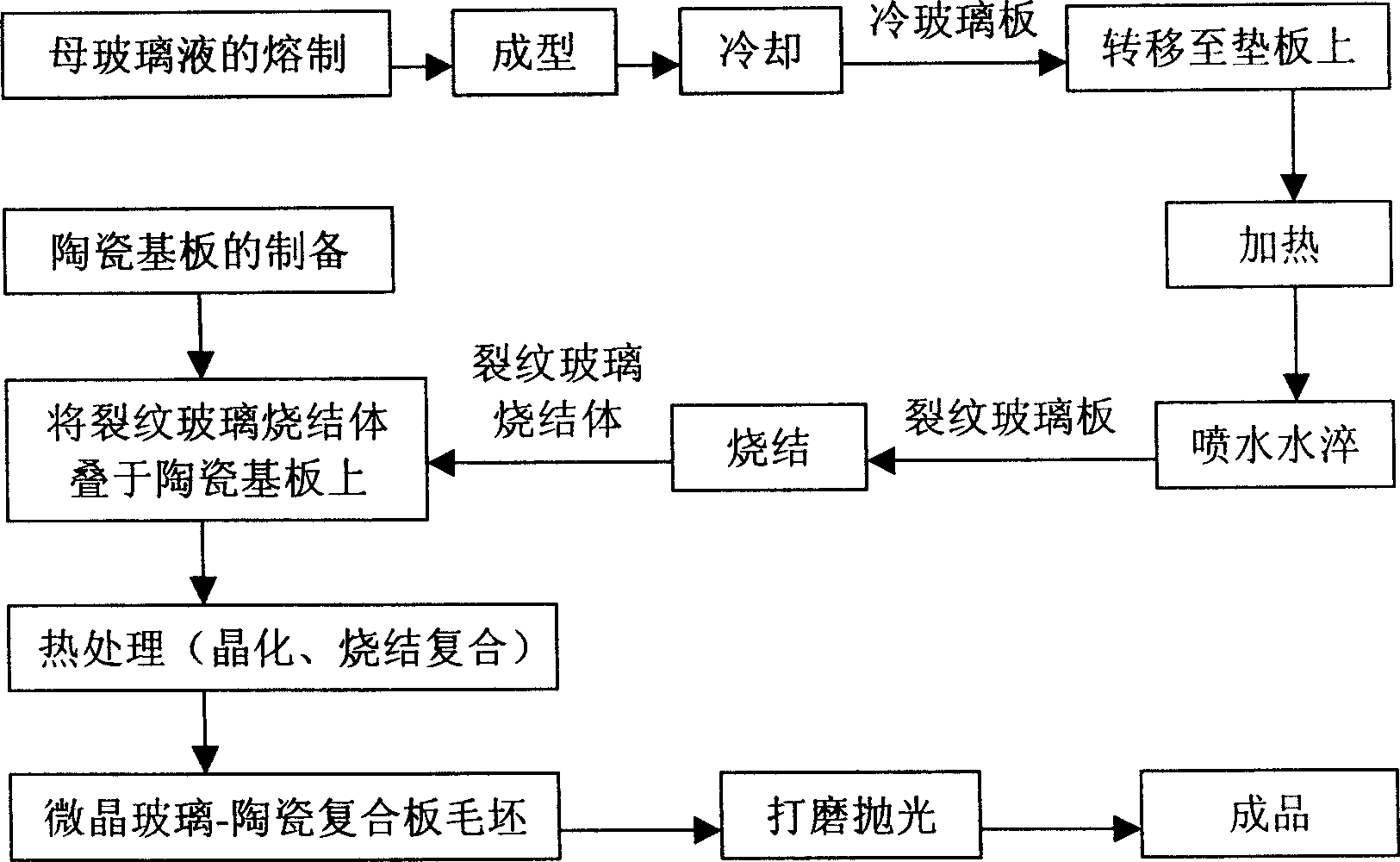Process for preparing microcrystal glass-ceramic compounded plate
A glass-ceramic and ceramic composite technology is applied in the field of preparation of glass-ceramic composite plates, which can solve the problems of pore defects and single texture, and achieve the effects of low porosity, elegant taste, and rich and varied texture styles.
- Summary
- Abstract
- Description
- Claims
- Application Information
AI Technical Summary
Problems solved by technology
Method used
Image
Examples
Embodiment 1
[0038] A preparation method of glass-ceramic-ceramic composite plate, such as figure 1 As shown, it includes the following steps:
[0039] 1) Preparation of ceramic substrate: use conventional ceramic raw materials, raw material ratio (expressed in mass percentage, the same in the following examples) is: 39.0% feldspar, 13%.0 quartz, 45.0% clay, 3.0% talc, raw material mixing The chemical composition of the material (expressed in mass percent, the same in the following examples) is: 67.90% SiO 2 , 19.50%Al 2 o 3 , 0.50% CaO, 0.90% MgO, 1.50% K 2 O; 2.50% Na 2 O, 0.40%TFe 2 o 3 , 0.10%TiO 2 , loss on ignition 6.40%, and other ingredients 0.30%; each raw material is weighed according to the formula, put into a ball mill, and wet ball milled to a particle size of 4% over a million-hole sieve; spray-dried to make materials, and the moisture content of the powder is 7%; The ceramic brick press is pressed and formed, and dried in a drying kiln to obtain a dry ceramic green b...
Embodiment 2
[0045] A kind of preparation method of glass-ceramic-ceramic composite plate, such as figure 2 As shown, it includes the following steps:
[0046] 1) Preparation of ceramic substrates: using conventional ceramic raw materials, the raw material ratio is: 39.0% feldspar, 13.0% quartz, 45.0% clay, 3.0% talc, the chemical composition of the raw material mixture is: 67.90% SiO 2 , 19.50%Al 2 o 3 , 0.50% CaO, 0.90% MgO, 1.50% K 2 O; 2.50% Na 2 O, 0.40%TFe 2 o 3 , 0.10%TiO 2 , loss on ignition 6.40%, and other ingredients 0.30%; each raw material is weighed according to the formula, put into a ball mill, and wet ball milled to a particle size of 4% over a million-hole sieve; spray-dried to make materials, and the moisture content of the powder is 7%; The ceramic brick press is pressed into shape, and dried in a drying kiln; the dried ceramic green body is kept at 1210°C for 20 minutes, and fired into a ceramic green body, which is used as a ceramic substrate for later use;
...
Embodiment 3
[0051] A preparation method of glass-ceramic-ceramic composite plate, such as image 3 As shown, it includes the following steps:
[0052] 1) Preparation of ceramic substrates: using conventional ceramic raw materials, the raw material ratio is: 39.0% feldspar, 13%.0 quartz, 45.0% clay, 3.0% talc, the chemical composition of the raw material mixture is: 67.90% SiO 2 , 19.50%Al 2 o 3 , 0.50% CaO, 0.90% MgO, 1.50% K 2 O; 2.50% Na 2 O, 0.40%TFe 2 o 3 , 0.10%TiO 2 , loss on ignition 6.40%, and other ingredients 0.30%; each raw material is weighed according to the formula, put into a ball mill, and wet ball milled to a particle size of 4% over a million-hole sieve; spray-dried to make materials, and the moisture content of the powder is 7%; The ceramic brick press is pressed into shape, and dried in a drying kiln; the dried ceramic green body is kept at 1210°C for 20 minutes, and fired into a ceramic green body, which is used as a ceramic substrate for later use;
[0053] 2...
PUM
| Property | Measurement | Unit |
|---|---|---|
| thickness | aaaaa | aaaaa |
| thickness | aaaaa | aaaaa |
Abstract
Description
Claims
Application Information
 Login to View More
Login to View More - R&D
- Intellectual Property
- Life Sciences
- Materials
- Tech Scout
- Unparalleled Data Quality
- Higher Quality Content
- 60% Fewer Hallucinations
Browse by: Latest US Patents, China's latest patents, Technical Efficacy Thesaurus, Application Domain, Technology Topic, Popular Technical Reports.
© 2025 PatSnap. All rights reserved.Legal|Privacy policy|Modern Slavery Act Transparency Statement|Sitemap|About US| Contact US: help@patsnap.com



